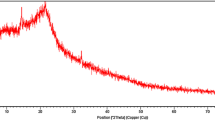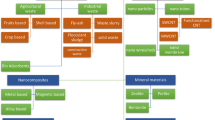Abstract
In this article, adsorption modelling was presented to describe the sorption of textile dye, Direct Red 75 (DR75), from coloured wastewater onto the natural and modified adsorbent, Posidonia oceanica. The formulation of the double-layer model with two energy levels was based on statistical physics and theoretical considerations. Thanks to the grand canonical ensemble in statistical physics some physico-chemical parameters related to the adsorption process were introduced in the analytical model expression. Fitting results show that the dye molecules are adsorbed in parallel position to the adsorbent surface. The magnitudes of the calculated adsorption energies show that the DR75 dye is physisorbed onto Posidonia. Both Van der Waals and hydrogen interactions are implicated in the adsorption process. Despite its simplicity, the model fits a wide range of experimental data, thereby supporting the underlying data that the grafted groups facilitate the parallel anchorage of the anionic dye molecule. Thermodynamic parameters, such as adsorption energy, entropy, Gibbs free adsorption energy and internal energy were calculated according to the double-layer model. Results suggested that the DR75 adsorption onto Posidonia was a spontaneous and exothermic process.










Similar content being viewed by others
References
Aguir C, Khalfaoui M, Laribi N, M’henni MF (2009) Preparation and characterization of new succinic anhydride grafted Posidonia for the removal of organic and inorganic pollutants. J Hazard Mater 172:1579–1590
Aksu Z (2005) Application of biosorption for the removal of organic pollutants: a review. Process Biochem 40:997–1026
Bae JS, Freeman HS (2007) Aquatic toxicity evaluation of new direct dyes to the Daphnia magna. Dyes Pigments 73:81–85
Batzias FA, Sidiras DK (2007) Simulation of methylene blue adsorption by salts-treated beech sawdust in batch and fixed-bed systems. J Hazard Mater 149:8–17
Boaventura D, Alexander M, Santina PD, Smith ND, Ré P, Fonseca LCD, Hawkins SJ (2002) The effects of grazing on the distribution and composition of low-shore algal communities on the central coast of Portugal and on the southern coast of Britain. J Exp Mar Biol Ecol 267:185–206
Burlica R, Kirkpatrick MJ, Finney WC, Clark RJ, Locke BR (2004) Organic dye removal from aqueous solution by glidarc discharges. J Electrost 62:309–321
Cengiz S, Tanrikulu F, Aksu S (2012) An alternative source of adsorbent for the removal of dyes from textile waters: Posidonia oceanica (L.). Chem Eng J 189–190:32–40
Chen BY (2002) Understanding decolorization characteristics of reactive azo dyes by Pseudomonas luteola: toxicity and kinetics. Process Biochem 38:437–446
Chong MN, Jin B, Chow CWK, Saint C (2010) Recent developments in photocatalytic water treatment technology: a review. Water Res 44:2997–3027
Churchley JH, Greaves AJ, Hutchings MG, James AE, Phillips DAS (2000) The development of a laboratory method for quantifying the bioelimination of anionic, water soluble dyes by a biomass. Water Res 34:1673–1679
Couillard D (1994) The use of peat in wastewater treatment. Water Res 28:1261–1274
Czyzewski A, Karolczyk J, Usarek A, Przepiorski J (2012) Removal of two ionic dyes from water by MgO-loaded porous carbons prepared through one step process from poly(ethylene-terephthalate)/magnesium carbonate mixtures. Bull Mater Sci 35:211–219
Gottlieb A, Shaw C, Smith A, Wheatley A, Forsythe S (2003) The toxicity of textile reactive azo dyes after hydrolysis and decolourisation. J Biotechnol 101:49–56
Horacek J, Soukupova L, Puncochar M, Slezcak J, Drahos J, Yosida K, Tsutsumi A (1994) Purification of waste waters containing low concentrations of heavy metals. J Hazard Mater 37:69–76
Jacob S (1980) Organized monolayers by adsoeprion. 1. Formation and structure of oleophobic mixed monolayers on solid surfaces. J Am Chem Soc 102:92–98
Khalfaoui M, Baouab MHV, Gauthier R, Ben Lamine A (2002) Dye adsorption by modified cotton. Steric and energetic interpretations of model parameter behaviours. Adsorpt Sci Technol 20:33–47
Khalfaoui M, Knani S, Hachicha MA, Ben Lamine A (2003) New theoretical expressions for the five adsorption type isotherms classified by BET based on statistical physics treatment. J Colloid Interface Sci 263:350–356
Khalfaoui M, Baouab MHV, Gauthier R, Ben Lamine A (2006) Acid dye adsorption onto cationized polyamide fibres. Modeling and consequent interpretations of model parameter behaviours. J Colloid Interface Sci 296:419–427
Khalfaoui M, Nakhli A, Knani S, Baouab MHV, Ben Lamine A (2012) On the statistical physics modeling of dye adsorption onto anionized nylon: consequent new interpretations. J Appl Polym Sci 125:1091–1102
Knani S, Khalfaoui M, Hachicha MA, Ben Lamine A, Mathlouthi M (2012) Modelling of water vapour adsorption on foods products by a statistical physics treatment using the grand canonical ensemble. Food Chem 132:1686–1692
Kousha M, Daneshvar E, Sohrabi MS, Jokar M, Bhatnagar A (2012) Adsorption of acid orange II dye by raw and chemically modified brown macroalga Stoechospermum marginatum. Chem Eng J 192:67–76
Lee YH, Pavlostathis SG (2004) Decolorization and toxicity of reactive anthraquinone textile dyes under methanogenic conditions. Water Res 38:838–1852
Liu CH, Wu JS, Chiu HC, Suen SY, Chu KH (2007) Removal of anionic reactive dyes from water using anion exchange membranes as adsorbers. Water Res 41:1491–1500
McKay G, Ramprasad G, Mowli P (1987) Desorption and regeneration of dye colours from low-cost materials. Water Res 21:375–377
Michaels GB, Lewis DL (1985) Sorption and toxicity of azo and triphenylmethane dyes to aquatic microbial populations. Environ Toxicol Chem 4:45–50
Ncibi MC, Mahjoub B, Ben Hamissa AM, Ben Mansour R, Seffen M (2009) Biosorption of textile metal-complexed dye from aqueous medium using Posidonia oceanica (L.) leaf sheaths: mathematical modelling. Desalination 243:109–121
Nemr AE, Abdelwahab O, El-Sikaily A, Khaled A (2009) A removal of direct blue-86 from aqueous solution by new activated carbon developed from orange peel. J Hazard Mater 161:102–110
Shakira K, Elkafrawyb AF, Ghoneimya HF, Beheira SGE, Refaata M (2010) Removal of rhodamine B (a basic dye) and thoron (an acidic dye) from dilute aqueous solutions and wastewater simulants by ion flotation. Water Res 44:1449–1461
Wahab MA, Ben Hassine R, Jellali S (2011) Posidonia oceanica (L.) fibers as a potential low-cost adsorbent for the removal and recovery of orthophosphate. J Hazard Mater 191:333–341
Weng CH (2002) Adsorption characteristics of new coccine dye onto sludge ash. Adsorpt Sci Technol 20:669–681
Author information
Authors and Affiliations
Corresponding author
Additional information
Responsible editor: Michael Matthies
Rights and permissions
About this article
Cite this article
Khalfaoui, M., Nakhli, A., Aguir, C. et al. Statistical thermodynamics of adsorption of dye DR75 onto natural materials and its modifications: double-layer model with two adsorption energies. Environ Sci Pollut Res 21, 3134–3144 (2014). https://doi.org/10.1007/s11356-013-2263-z
Received:
Accepted:
Published:
Issue Date:
DOI: https://doi.org/10.1007/s11356-013-2263-z




